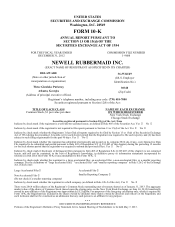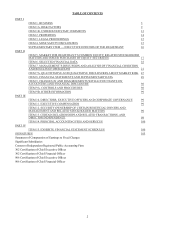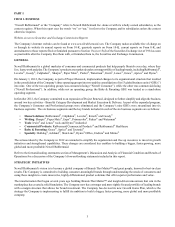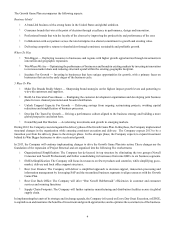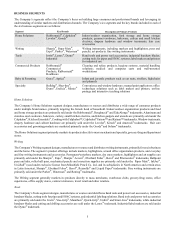Graco 2012 Annual Report Download - page 17
Download and view the complete annual report
Please find page 17 of the 2012 Graco annual report below. You can navigate through the pages in the report by either clicking on the pages listed below, or by using the keyword search tool below to find specific information within the annual report.11
Circumstances associated with divestitures and product lines exits could adversely affect the Company's results of
operations and financial condition.
The Company continues to evaluate the performance and strategic fit of its businesses and products and may decide to sell or
discontinue a business or product based on such an evaluation. A decision to divest or discontinue a business or product may result
in asset impairments, including those related to goodwill and other intangible assets, and losses upon disposition, both of which
could have an adverse effect on the Company's results of operations and financial condition. In addition, the Company may
encounter difficulty in finding buyers or executing alternative exit strategies at acceptable prices and terms and in a timely manner.
In addition, prospective buyers may have difficulty obtaining financing. Divestitures and business discontinuations could involve
additional risks, including the following:
• difficulties in the separation of operations, services, products and personnel;
• the diversion of management's attention from other business concerns;
• the retention of certain current or future liabilities in order to induce a buyer to complete a divestiture;
• the disruption of the Company's business; and
• the potential loss of key employees.
The Company may not be successful in managing these or any other significant risks that it may encounter in divesting or
discontinuing a business or exiting product lines.
The Company is subject to risks related to its international operations and sourcing model.
International operations, especially in Europe, but also in Asia, Central and South America, and Canada, are important to the
Company's business, and the Company's strategy emphasizes international growth. In addition, as the Company sources products
in low-cost countries, particularly in Asia, it is exposed to additional risks and uncertainties. Foreign operations can be affected
by factors such as currency devaluation; other currency fluctuations; tariffs; nationalization; exchange controls; labor inflation;
interest rates; limitations on foreign investment in local business; and other political, economic and regulatory risks and difficulties.
The Company also faces risks due to the transportation and logistical complexities inherent in reliance on foreign sourcing.
Venezuela was designated as a highly inflationary economy effective January 1, 2010, and, accordingly, gains and losses resulting
from the translation of the net assets (excluding nonmonetary assets) of operations in Venezuela into U.S. Dollars are recorded in
earnings. In February 2013, the exchange rate for the Venezuelan currency, Bolivar Fuerte, declined approximately 15%, which
will adversely impact the Company’s financial results. The Company is unable to predict with certainty whether future devaluations
will occur because of the economic uncertainty in Venezuela; however, future devaluations would adversely impact the Company’s
future financial results. See Footnote 1 of the Notes to Consolidated Financial Statements and Management’s Discussion and
Analysis of Financial Condition and Results of Operations for further information.
The inability to obtain raw materials and finished goods in a timely manner from suppliers would adversely affect the
Company's ability to manufacture and market its products.
The Company purchases raw materials to be used in manufacturing its products. In addition, the Company relies on third-party
manufacturers as a source for finished goods. The Company typically does not enter into long-term contracts with its suppliers or
sourcing partners. Most raw materials and sourced goods are obtained on a “purchase order” basis; however, in limited cases where
the Company has supply contracts with fixed prices, the Company may be required to purchase raw materials at above-market
prices, which could adversely impact gross margins. In addition, in some instances the Company maintains single-source or limited-
source sourcing relationships, either because multiple sources are not available or the relationship is advantageous due to
performance, quality, support, delivery, capacity or price considerations. In particular, the Company's Baby & Parenting business
has a single source of supply for many of its products. Financial, operating or other difficulties encountered by the Company's
suppliers and/or sourcing partners or changes in the Company's relationships with them could result in manufacturing or sourcing
interruptions, delays and inefficiencies, and prevent the Company from manufacturing or obtaining the finished goods necessary
to meet customer demand.
Complications in connection with the Company's current information system initiative may adversely impact its results
of operations, financial condition and cash flows.
The Company is in the process of replacing various business information systems worldwide with an enterprise resource planning
system from SAP. Through December 31, 2012, the North American and European operations of substantially all of the Company's
six segments have successfully gone live with their SAP implementation efforts. The Company's Asia Pacific and Latin American
operations have yet to go live on SAP. This activity involves the migration of multiple legacy systems and users to a common SAP
information platform. Throughout this process, the Company is changing the way it conducts business and employees' roles in


